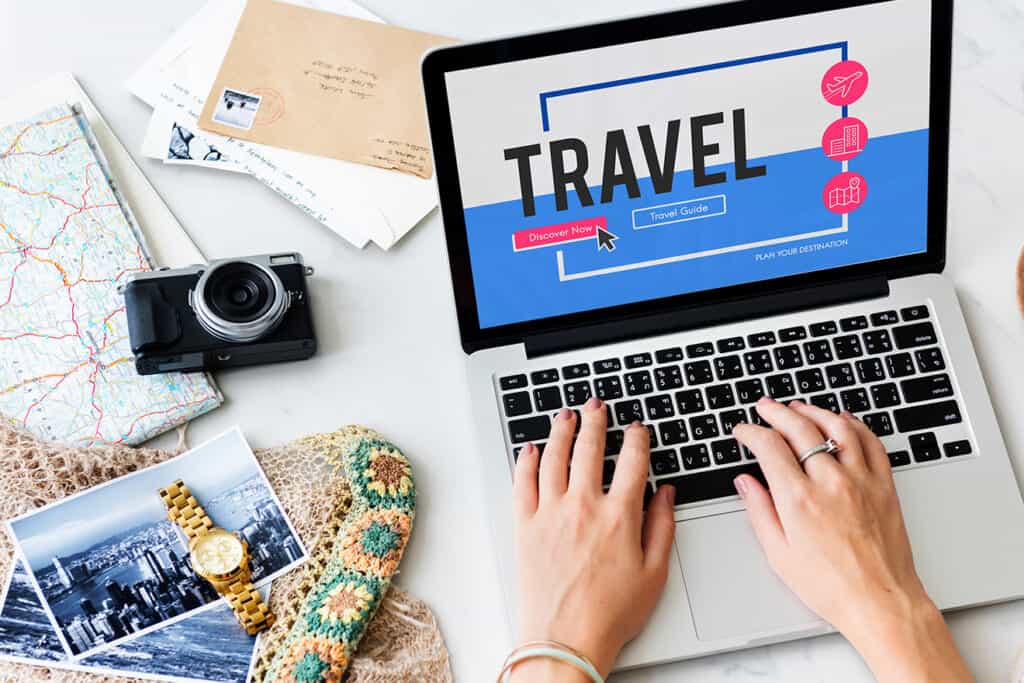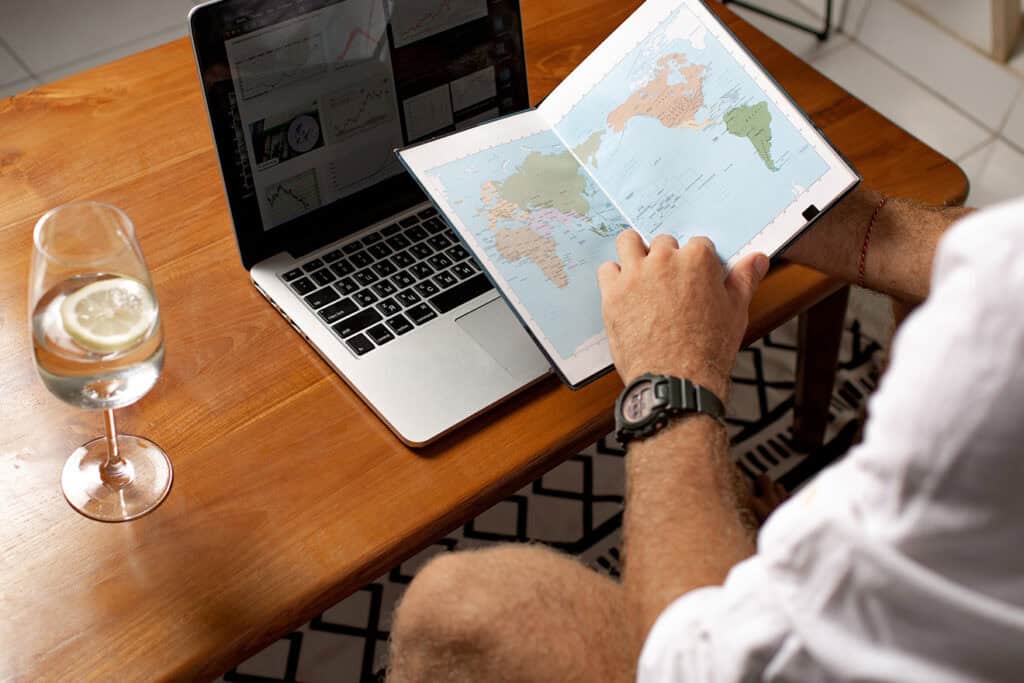
FREE Download For You
Download Your
Blog Optimization Checklist
Ah, another soul bitten by the wanderlust bug—I knew I wasn’t alone! I know you’ve been bitten by the wanderlust bug. You’re constantly daydreaming about your next adventure, capturing stunning photos, and jotting down unforgettable stories in your journal. But what if I told you that you could turn your passion for travel into a successful blog? Yep, you read that right!
Blogging about travel is more than just sharing your experiences with the world. It’s about inspiring others, building a community of like-minded explorers, and potentially even making a living doing what you love. And the best part? You don’t need to be a tech wizard or a professional writer to get started.
Here’s a quick walkthrough on launching a travel diary online that screams ‘you’. I’m on deck for everything from nailing down what makes you unique, creating stuff people can’t scroll past, to boosting your followers. So, grab your virtual passport, and let’s embark on this exciting journey together!
Table of Contents:
- How to Start a Successful Travel Blog in 2024
- Essential Steps for Setting Up Your Travel Blog
- Crafting Compelling Content for Your Travel Blog
- Building a Strong Online Presence and Growing Your Audience
- Monetization Strategies for Your Travel Blog
- Designing an Attractive and User-Friendly Travel Blog
- Overcoming Challenges and Achieving Long-Term Success
- Conclusion
How to Start a Successful Travel Blog in 2024
So many of the biggest travel bloggers write these guides but have no idea how to gain success in 2024 because they all did it back in 2010. The tactics that worked back then (back when Instagram didn’t even exist.) are the opposite of what works now.
I know what works in 2024 because I’ve been successful within the past year.
So with that out of the way, let’s jump into the article.
Here’s how to start a travel blog in 2024:
Choosing a Niche
Luckily, there’s space for both approaches when it comes to travel blogging. When you’re just getting off the ground, though, it’s important to make a few decisions to guide your future adventures.
Do you want to focus on domestic or international travel? Are you interested in every continent, or is there a specific region you want to become an expert in?
Do you prefer posting “guidebook-like” content, or do you want to share experiences, memories and mishaps instead? Does documenting the practical logistics of travel appeal to you, or are you the type to like traveling the world as a free spirit and bringing your readers along for the spontaneous ride?
Setting Up Your Website
To help with the process, this article will provide a step-by-step tutorial on how to start a travel blog website – from researching the niche to making money blogging.
The first step is choosing a domain name. Avoid anything not likely to age well or that limits you to a certain type of content: “21 and Traveling” or “American Adventures” are cute but might become tough to spin once you get older or travel out of America.
Next, you’ll need reliable web hosting. Look for a provider with 99.9% uptime, 24/7 support, and a user-friendly control panel. I recommend Hostinger for their affordable plans and excellent service.
Creating Engaging Content
Writing a travel blog will require you to do more than share general travel information, or post about your daily itinerary. In order for readers to find your blog valuable, and keep coming back, it must be both informative and engaging, and bring a perspective that is fresh, unique, or otherwise different than all the other travel blogs out there.
Here are a few tips to make your blog more engaging:
- Share personal stories and anecdotes
- Use vivid descriptions to paint a picture
- Incorporate high-quality photos and videos
- Write in a conversational, relatable tone
- Provide practical tips and advice based on your experiences
Networking in the Travel Industry
Social media will play an essential role, both in marketing your travel blog to readers and networking with others within the travel community. Friend and Follow as many travel professionals as you can find, and post consistently to help gain more followers in your niche – and to show travel professionals your level of dedication, and ability to generate attention.
Collaborating with other travel bloggers is another great way to expand your reach. Guest post on each other’s blogs, share each other’s content, and even consider co-hosting a webinar or creating a joint product.
Monetizing Your Blog
If you’re looking for a well-paying job that lets you travel, becoming a professional travel blogger is an excellent option. But without the right approach, starting a blog from scratch can be challenging and time-consuming.
Some popular monetization strategies include:
- Joining affiliate programs
- Offering sponsored content and partnerships
- Creating digital products like ebooks or courses
- Providing travel planning services
- Placing ads on your website
The key is to diversify your income streams and not rely on just one method. It takes time to start seeing significant income, but with persistence and hard work, it’s possible to turn your travel blog into a full-time business.
Essential Steps for Setting Up Your Travel Blog
To help with the process, this article will provide a step-by-step tutorial on how to start a travel blog website – from researching the niche to making money blogging.
Selecting a Domain Name
Your domain name is your blog’s address on the web. It should be memorable, easy to spell, and reflective of your brand. Avoid using hyphens, numbers, or anything too long and complicated.
I recommend using a .com extension as it’s the most common and easiest for people to remember. You can use a tool like Lean Domain Search to brainstorm ideas and check availability.
Choosing a Reliable Hosting Provider
Web hosting is a service that allows your website to be accessed on the internet. It’s important to choose a reliable provider with good uptime, fast loading speeds, and excellent customer support.
I personally use and recommend Hostinger for their affordable hosting plans, user-friendly interface, and 24/7 live chat. They also offer domain privacy protection and free SSL certificates.
Installing WordPress
WordPress is the most popular content management system for building websites and blogs. It’s free, open-source, and highly customizable with thousands of themes and plugins available.
Most web hosts offer one-click WordPress installation, making it quick and easy to get started. If you’re using Hostinger, simply log into your hosting account, find the Auto Installer, and click on WordPress. Enter your admin information and your site will be ready in minutes.
Configuring Essential Plugins
Plugins are like apps for your WordPress site. They add extra features and functionality to your blog. Some essential plugins for a travel blog include:
- Yoast SEO for optimizing your content for search engines
- Jetpack for security, performance, and site stats
- Akismet for preventing spam comments
- WP Super Cache for improving site speed
- Contact Form 7 for adding a contact form to your site
To install a plugin, go to your WordPress dashboard, click on Plugins > Add New, search for the plugin name, and click Install Now. Remember to activate the plugin after installation.
Selecting an Attractive Theme
Your website theme determines the overall look and feel of your blog. It should be visually appealing, mobile-friendly, and easy to navigate.
There are thousands of free and paid WordPress themes available. Some popular options for travel blogs include Divi, Astra, OceanWP, and GeneratePress. Many themes come with pre-built templates and drag-and-drop page builders to make customization easier.
When selecting a theme, consider your niche, branding, and the type of content you’ll be publishing. Look for a theme that’s lightweight, SEO-friendly, and regularly updated by the developer.
Crafting Compelling Content for Your Travel Blog
Writing a travel blog will require you to do more than share general travel information, or post about your daily itinerary. In order for readers to find your blog valuable, and keep coming back, it must be both informative and engaging, and bring a perspective that is fresh, unique, or otherwise different than all the other travel blogs out there.
Developing a Content Strategy
Before you start writing blog posts, it’s important to develop a content strategy. This involves:
- Defining your target audience
- Identifying your unique angle or perspective
- Researching keywords and topics to write about
- Creating an editorial calendar to plan and schedule your posts
Your content strategy should align with your overall blogging goals, whether that’s to inspire others to travel, provide practical advice and tips, or share your personal journey and experiences.
Writing Engaging Blog Posts
When it comes to writing travel articles, there are a few key elements to keep in mind:
- Start with a strong headline that grabs attention
- Use short paragraphs and subheadings to break up the text
- Incorporate storytelling techniques to make your posts more engaging
- Provide value to your readers, whether that’s travel tips, destination guides, or personal insights
- End with a call-to-action, such as encouraging readers to leave a comment or share the post
Remember to write in a conversational tone, as if you’re talking to a friend. Use descriptive language to paint a picture and transport your readers to the destination you’re writing about.
Incorporating High-Quality Images and Videos
Visuals are a crucial component of any travel blog. High-quality photos and videos can help bring your stories to life and make your posts more engaging.
Invest in a good camera or smartphone with a quality lens. Learn some basic photography techniques, such as composition, lighting, and editing. You don’t need to be a professional photographer, but having visually appealing images can make a big difference.
In addition to photos, consider incorporating videos into your blog posts. You can create travel vlogs, destination guides, or behind-the-scenes footage to give your readers a more immersive experience.
Sharing Personal Travel Experiences
One of the most effective ways to connect with your audience is by sharing your personal travel experiences and stories. Readers want to know about the challenges you faced, the people you met, and the lessons you learned along the way.
Don’t be afraid to be vulnerable and share your thoughts and emotions. Write about the good, the bad, and the ugly of travel. Your unique perspective and voice are what will make your blog stand out from the rest.
Providing Valuable Travel Tips and Advice
In addition to sharing your personal experiences, it’s important to provide practical travel tips and advice that your readers can use. This can include:
- Destination guides with recommendations on where to stay, eat, and explore
- Packing lists and gear recommendations
- Budget travel tips and ways to save money
- Advice on planning trips, booking flights and accommodations, and navigating transportation
- Cultural insights and etiquette tips for different countries
The more informative and helpful your content is, the more likely readers will be to trust you as a travel expert and keep coming back to your blog for advice.
Building a Strong Online Presence and Growing Your Audience
Creating great content is just one part of running a successful travel blog. You also need to focus on building a strong online presence and growing your audience.
Leveraging Social Media Platforms
Social media will play an essential role, both in marketing your travel blog to readers and networking with others within the travel community. Friend and Follow as many travel professionals as you can find, and post consistently to help gain more followers in your niche – and to show travel professionals your level of dedication, and ability to generate attention.
Some key social media platforms for travel bloggers include:
- Instagram for sharing photos and short videos
- Facebook for building a community and sharing blog posts
- Twitter for networking and participating in travel chats
- Pinterest for driving traffic to your blog
- YouTube for creating travel vlogs and video content
Engaging with Your Target Audience
Building an engaged community around your blog is crucial for long-term success. Respond to comments on your blog and social media posts. Ask questions and encourage discussions. Share user-generated content and feature your readers on your platforms.
You can also engage with your target audience by:
- Sending out a regular newsletter with exclusive content and updates
- Hosting giveaways and contests
- Attending travel conferences and meetups
- Collaborating with other bloggers and brands in your niche
Collaborating with Other Travel Bloggers
Collaborating with other bloggers in the travel community can help expose your blog to a new audience and provide opportunities for growth. Some ways to collaborate include:
- Guest posting on each other’s blogs
- Participating in collaborative blog posts or social media projects
- Attending or hosting travel blogger retreats and workshops
- Sharing each other’s content on social media
- Partnering on product launches or affiliate campaigns
Monetization Strategies for Your Travel Blog
If you’re looking for a well-paying job that lets you travel, becoming a professional travel blogger is an excellent option. But without the right approach, starting a blog from scratch can be challenging and time-consuming.
There are various monetization opportunities for travel blogs. You can use one or a few of them depending on your content, audience, and business goals. Here are the most popular ideas:
Joining Affiliate Programs
My suggestion is to start by joining affiliate programs for brands you love and find ways to plug them as hard (and as softly) as you can.
Affiliate links are a great way to start making money with your travel blog. When someone clicks your special tracking link and makes a purchase, you earn a commission.
Amazon Associates is a popular option. But there are also affiliate programs specific to travel, like Booking.com, Expedia, and World Nomads.
The key is to only promote products and services you truly believe in and would recommend anyway. Your audience can smell inauthenticity from a mile away.
As your blog grows, you may get opportunities for sponsored content and partnerships. A hotel, tour company, or tourism board might invite you for a free or discounted stay in exchange for a review or social media coverage.
I’ve been lucky to score some incredible hotel stays and press trips over the years. But I’m always transparent with my audience about the nature of the partnership.
Sponsored posts can be lucrative. But it’s important to maintain your integrity and only work with brands that align with your values and niche.
Offering Travel Planning Services
If you’ve become an expert on a certain destination, consider offering travel planning services. People will pay good money for personalized itineraries, insider tips, and recommendations.
You can offer different packages at various price points, from a simple one-hour consultation to planning an entire trip from start to finish. It’s a great way to monetize your knowledge and experience.
Another option is to create and sell your own digital products. This could be anything from e-books and courses to Lightroom presets and photo filters.
Think about what unique value you can offer based on your skills and niche. Maybe it’s a guide to taking stunning travel photos, a course on budget backpacking, or an e-book with your top 100 travel hacks.
The beauty of digital products is that you create them once and can sell them over and over again. It’s a great way to create passive income from your travel blog.
Exploring Advertising Opportunities
Display ads are a good way to start generating income, though they might deter some readers. Google AdSense is the most popular option. But there are also ad networks specific to travel blogs, like Mediavine and AdThrive.
The key is to strike a balance between monetization and user experience. Too many ads can be annoying and drive people away from your site.
I prefer to keep my site clean and use advertising sparingly. But some bloggers make a full-time income from display ads alone. It’s all about finding what works for you and your audience.
Designing an Attractive and User-Friendly Travel Blog
When it comes to travel blogging, first impressions matter. A lot.
You could have the best content in the world. But if your site looks like it’s straight out of 1999, people aren’t going to stick around long enough to read it.
That’s why investing time into good design is so important. Here are some key things to consider:
Your travel blog logo is often the first thing people will notice. It’s the face of your brand. So it’s worth putting some thought into it.
If you have graphic design skills, great. If not, consider hiring a professional designer to create a logo that captures the essence of your blog.
Your logo should be simple, memorable, and versatile. It should look good in color and black and white, at large and small sizes.
Choosing a Color Scheme and Typography
Your color scheme and typography play a big role in the overall look and feel of your site. They should be consistent across all pages and reflect your brand personality.
Are you fun and playful? Elegant and sophisticated? Rugged and adventurous? Your colors and fonts should convey that.
Limit yourself to 2-3 main colors and 1-2 accent colors. Use a tool like Adobe Color or Coolors to find a palette that works.
For typography, stick to 2-3 fonts max. A good rule of thumb is a serif for headlines, sans-serif for body text, and a decorative font for accents (used sparingly).
In 2023, having a mobile-friendly site is non-negotiable. Over half of web traffic worldwide comes from mobile devices.
Make sure your theme is responsive and looks good on screens of all sizes. Test it on your own phone and tablet.
Consider things like font size, button placement, and image scaling. Is everything easily readable and clickable on a small screen?
A mobile-friendly site isn’t just good for users. It’s good for SEO too. Google prioritizes mobile-optimized sites in its search results.
Ensuring Easy Navigation
Your site should be intuitive and easy to navigate. Visitors should be able to find what they’re looking for in just a few clicks.
Put some thought into your menu structure. Keep it simple and logical, with clear labels. Use drop-downs sparingly.
Include a search bar so people can quickly find specific content. And don’t forget about breadcrumbs, which show the path back to the homepage.
Make it easy for people to browse your archives by category, date, or location. The easier your site is to navigate, the longer people will stay.
Enhancing User Experience
Good user experience (UX) goes beyond just design and navigation. It’s about anticipating your visitors’ needs and making their journey on your site as smooth as possible.
That means fast load times, intuitive forms, helpful error messages, and clear calls-to-action. Every element on your site should serve a purpose.
Put yourself in your reader’s shoes. What information are they looking for? What actions do you want them to take? Make it easy for them to do those things.
Little touches like a “back to top” button, related post suggestions, and a well-designed 404 page can make a big difference in UX.
Overcoming Challenges and Achieving Long-Term Success
Successful travel bloggers make it look effortless. They’re always jetting off to some new exotic location, laptop in tow, living the dream.
But the reality is, travel blogging is a lot of work. It’s not all glamorous press trips and passive income. Behind every successful blog is a whole lot of hustle.
Here are some of the biggest challenges travel bloggers face, and how to overcome them:
When you’re a full-time travel blogger, time is your most precious resource. There’s always more to do than hours in the day.
Between planning trips, writing posts, editing photos, promoting on social media, and all the behind-the-scenes admin work, it’s easy to get overwhelmed.
The key is to prioritize ruthlessly. Focus on the 20% of tasks that will bring 80% of the results. Learn to say no to opportunities that don’t align with your goals.
Batch similar tasks together to be more efficient. Use tools like Trello or Asana to stay organized and on track.
And don’t be afraid to outsource or automate certain tasks as your blog grows. Your time is better spent on high-level strategy than scheduling tweets.
Staying Motivated and Consistent
Travel blogging is a marathon, not a sprint. It takes time to build an audience and start seeing real results.
In those early days, when you feel like you’re shouting into the void, it’s easy to get discouraged. Imposter syndrome kicks in and you start doubting yourself.
The key is to stay focused on your why. Remember the reason you started blogging in the first place. Was it to share your love of travel? To inspire others? To build a location-independent lifestyle?
Keep that bigger purpose front and center. Celebrate the small wins along the way. And don’t compare yourself to other bloggers who may be further along in their journey.
Consistency is also crucial. Commit to a regular posting schedule, whether that’s once a week or once a month. Show up for your audience even when you don’t feel like it.
The travel industry is constantly evolving, and successful bloggers need to evolve with it. What worked five years ago may not work today.
Stay on top of industry trends and be willing to pivot when necessary. That might mean branching out into new social media platforms, experimenting with different types of content, or even niching down further.
For example, when the pandemic hit and travel shut down, many bloggers had to get creative. They pivoted to local travel, virtual tours, or non-travel related content to stay afloat.
The key is to stay agile and open-minded. Embrace change as an opportunity to innovate and better serve your audience.
Continuously Improving Your Skills
The best travel bloggers are lifelong learners. They’re always looking for ways to improve their craft and up their game.
That might mean taking a writing course to hone your storytelling skills, learning SEO to boost your search rankings, or investing in better camera gear to take your photos to the next level.
Attend industry conferences and network with other bloggers. Join Facebook groups and online communities to stay plugged in.
Read widely, not just in the travel space. Draw inspiration from great writers, photographers, and marketers across all industries.
The more you invest in yourself and your skills, the better equipped you’ll be to weather any challenges that come your way.
Setting Realistic Goals and Expectations
It’s important to have big dreams and ambitious goals. But it’s equally important to be realistic about what it takes to achieve them.
Building a successful travel blog is not a get-rich-quick scheme. It takes time, hard work, and a whole lot of patience.
Don’t expect to quit your job and travel the world full-time right out of the gate. Set smaller, achievable milestones along the way.
Maybe your first goal is to land a press trip or sponsored post. Then it’s to hit 1,000 email subscribers. Then 10,000 monthly pageviews.
Break down your big, audacious goals into bite-sized chunks. Celebrate each milestone along the way.
And remember, success looks different for everyone. Don’t get caught up in vanity metrics or compare yourself to others.
Focus on creating great content, engaging with your audience, and staying true to your unique voice and perspective. The rest will follow.
Conclusion
When you blog about your journeys, it’s not just storytelling – it’s building bridges with like-minded souls and possibly turning that zeal for discovery into a profitable venture. By choosing your niche, setting up your blog, crafting compelling content, and engaging with your audience, you’ll be well on your way to building a successful travel blog.
Remember, success doesn’t happen overnight. To truly excel, embrace steady progress coupled with an eagerness to grow and shift gears when necessary. But with the right mindset and strategies, you can transform your travel blog into a go-to resource for fellow adventurers and even monetize your passion.
So, what are you waiting for? Start planning your next adventure, capture those unforgettable moments, and share your stories with the world. Your journey into travel blogging is kicking off, and it’s going to be a thrill seeing where this road leads you!

FREE Download For You
Download Your
Blog Optimization Checklist







